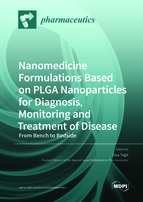Nanomedicine Formulations Based on PLGA Nanoparticles for Diagnosis, Monitoring and Treatment of Disease: From Bench to Bedside
A special issue of Pharmaceutics (ISSN 1999-4923). This special issue belongs to the section "Physical Pharmacy and Formulation".
Deadline for manuscript submissions: closed (30 December 2021) | Viewed by 54513
Special Issue Editor
Interests: quantum dots; FRET; polymers; immunoassays; molecular diagnostics
Special Issues, Collections and Topics in MDPI journals
Special Issue Information
Dear Colleagues,
Nanomedicine is among the most promising emerging fields that can provide innovative and radical solutions to unmet needs in pharmaceutical formulation development. Encapsulation of active pharmaceutical ingredients within nano-size carriers offers several benefits, namely, protection of the therapeutic agents from degradation, their increased solubility and bioavailability, improved pharmacokinetics, reduced toxicity, enhanced therapeutic efficacy, decreased drug immunogenicity, targeted delivery, and simultaneous imaging and treatment options with a single system.
Poly(lactide-co-glycolide) (PLGA) is one of the most commonly used polymers in nanomedicine formulations due to its excellent biocompatibility, tunable degradation characteristics, and high versatility. Furthermore, PLGA is approved by the European Medicines Agency (EMA) and the Food and Drug Administration (FDA) for use in pharmaceutical products. Nanomedicines based on PLGA nanoparticles can offer tremendous opportunities in the diagnosis, monitoring, and treatment of various diseases.
This Special Issue aims to focus on the bench-to-bedside development of PLGA nanoparticles including (but not limited to) design, development, physicochemical characterization, scale-up production, efficacy and safety assessment, and biodistribution studies of these nanomedicine formulations.
Dr. Oya Tagit
Guest Editor
Manuscript Submission Information
Manuscripts should be submitted online at www.mdpi.com by registering and logging in to this website. Once you are registered, click here to go to the submission form. Manuscripts can be submitted until the deadline. All submissions that pass pre-check are peer-reviewed. Accepted papers will be published continuously in the journal (as soon as accepted) and will be listed together on the special issue website. Research articles, review articles as well as short communications are invited. For planned papers, a title and short abstract (about 100 words) can be sent to the Editorial Office for announcement on this website.
Submitted manuscripts should not have been published previously, nor be under consideration for publication elsewhere (except conference proceedings papers). All manuscripts are thoroughly refereed through a single-blind peer-review process. A guide for authors and other relevant information for submission of manuscripts is available on the Instructions for Authors page. Pharmaceutics is an international peer-reviewed open access monthly journal published by MDPI.
Please visit the Instructions for Authors page before submitting a manuscript. The Article Processing Charge (APC) for publication in this open access journal is 2900 CHF (Swiss Francs). Submitted papers should be well formatted and use good English. Authors may use MDPI's English editing service prior to publication or during author revisions.
Keywords
- PLGA
- nanomedicine
- drug delivery
- encapsulation
- (pre)clinical imaging
- therapy
- scale-up manufacturing
- toxicity
- biodistribution







